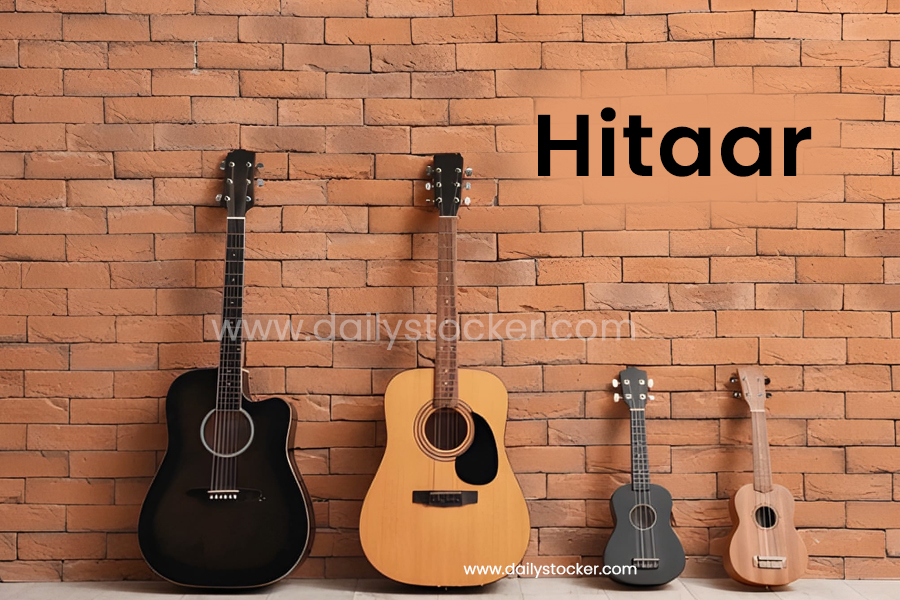Hitaar: The Timeless Art of Cultural Expression
Hitaar is not just an art form — it’s a living story that connects the human soul with rhythm, movement, and emotion. Originating centuries ago, hitaar evolved as a vibrant expression of community, culture, and identity. It combines music, gestures, and symbolism to tell stories that transcend language. Whether performed in rural villages or grand cultural festivals, hitaar has always been more than performance — it’s an experience of connection.
In simple words, hitaar is an expressive traditional art form that blends music, rhythm, and storytelling to reflect the soul of a culture. Over the years, it has evolved from ancient ritualistic traditions into a global form of artistic inspiration. Modern audiences may see hitaar as a bridge between history and innovation — where the past dances hand-in-hand with the present.
In today’s world of digital entertainment, where attention spans shrink and trends come and go, hitaar still holds its place because it’s deeply human. It reminds us that art isn’t just about watching or listening — it’s about feeling. That’s what makes hitaar so timeless.
The Origins of Hitaar: Where It All Began
The story of hitaar begins long before modern instruments and microphones. It started in ancient communities where expression was life itself. Before written words, people used rhythm, tone, and movement to communicate — and hitaar was born as a sacred and communal act.
Early forms of hitaar were performed in open gatherings under starlit skies. Villagers would form circles, singing and tapping basic instruments, while storytellers acted out historical or spiritual tales. These performances weren’t merely entertainment; they were part of rituals, celebrations, and even education.
Anthropologists suggest that hitaar likely originated in regions where oral storytelling and musical improvisation were central to culture. It was a way to remember ancestry, celebrate harvests, express love, and mourn loss — all through rhythm and motion.
With time, these expressions grew structured. Instruments were refined, musical scales developed, and hitaar transformed from local storytelling into an artistic discipline. It became both performance and preservation — a medium to keep history alive.
The Meaning and Philosophy Behind Hitaar
Every culture has its artistic heartbeat — and for many communities, hitaar is exactly that. The philosophy behind hitaar lies in harmony: between nature and humans, sound and silence, tradition and creativity.
At its core, hitaar is about balance. Its performances often explore the human condition — joy, sorrow, triumph, and humility — through synchronized rhythms and expressive movements. It teaches that art isn’t about perfection but connection.
In traditional philosophy, hitaar also represents the concept of unity through diversity. Each performer adds their own voice, gesture, or note, but the collective outcome is harmony. It’s a visual and auditory metaphor for life itself: individuals blending to create something larger than themselves.
The Cultural Significance of Hitaar
To truly understand the impact of hitaar, one must look beyond its artistic surface. It’s not just an art form — it’s a mirror of culture, reflecting values, traditions, and evolution.
1. A Keeper of History
Hitaar serves as a living archive. Through its performances, stories of ancestors, heroes, and community legends are passed down generation after generation. This storytelling element keeps history alive in a way no textbook can.
2. A Symbol of Identity
For many regions, hitaar represents identity — a distinct sound, rhythm, and performance style that separates one community from another. The instruments, costumes, and dance patterns differ, but the heart of hitaar remains the same: authenticity and belonging.
3. A Tool of Education
Before schools existed, hitaar was used to teach morals, wisdom, and collective values. Children learned about courage, honesty, and compassion through tales performed rhythmically and dramatically.
4. A Form of Resistance
Throughout history, art has often been rebellion in disguise. During times of oppression or conflict, hitaar became a subtle weapon — a way to express hope, unity, and cultural pride. Its songs carried hidden messages of resilience and empowerment.
Elements That Define Hitaar
What makes hitaar distinct from other traditional art forms? It’s the perfect fusion of sound, story, and spirit. Here are the elements that bring this beautiful art form to life:
1. Music and Rhythm
Music lies at the heart of hitaar. Whether created with hand drums, flutes, or string instruments, its rhythm guides every movement. The beats are repetitive yet layered, designed to pull both performer and audience into a trance-like experience.
2. Movement and Expression
Unlike many art forms that rely solely on instruments or vocals, hitaar integrates body language and gestures. Each hand movement, footstep, and facial expression carries meaning — symbolizing emotions and events.
3. Storytelling
Every hitaar performance tells a story — often of love, struggle, nature, or spirituality. Storytelling connects the audience emotionally, turning each performance into an immersive narrative.
4. Costumes and Symbolism
Traditional hitaar performances often feature colorful garments, masks, and ornaments that hold symbolic value. The colors represent moods (red for energy, white for peace, blue for devotion), while accessories may represent gods, spirits, or ancestors.
5. The Spirit of Improvisation
Although structured, hitaar allows performers creative freedom. Improvisation — whether through spontaneous drum beats or lyrical changes — keeps the art alive and dynamic. It’s never the same twice, much like the flow of life itself.
How Hitaar Evolved Through the Ages
Like every great art form, hitaar has evolved with time. What began as local ritual expression has grown into a recognized global art form. Let’s explore how hitaar has transformed through different eras:
1. The Ancient Roots
In ancient times, hitaar was primarily spiritual. It was performed during harvest festivals, royal ceremonies, and religious rituals. Its purpose was to honor gods, invite blessings, and celebrate unity.
2. The Folk Expansion
As communities expanded, hitaar became a folk tradition. Villages developed their own variations — some emphasizing drums, others dance or poetry. This regional diversity made hitaar richer and more colorful.
3. The Classical Period
Over centuries, certain forms of hitaar gained prestige in royal courts and temples. Scholars began documenting its patterns, and formal training emerged. This was when hitaar started to be viewed not just as entertainment but as an academic art form.
4. The Colonial Influence
During colonial eras, traditional arts often faced suppression or neglect. Yet, hitaar survived — adapting subtly to foreign influences without losing its native essence. Performers integrated new instruments and styles while maintaining traditional spirit.
5. The Modern Renaissance
Today, hitaar is witnessing a global renaissance. Artists fuse it with jazz, pop, and digital music to create cross-cultural masterpieces. Social media has also revived interest, making ancient traditions accessible to younger generations worldwide.
Hitaar as an Emotional Language
One reason hitaar continues to captivate audiences is its ability to speak without words. Its emotional intensity transcends language and geography.
Each rhythm and gesture is like a line of poetry. A slow beat may symbolize longing, while a fast tempo radiates joy. Audiences often describe feeling emotionally “moved” even when they don’t understand the lyrics — because hitaar communicates through the universal language of emotion.
This expressive power makes hitaar a bridge between cultures. Whether performed in a traditional village or an international theater, its message remains clear: emotion is universal, and so is art.
The Role of Hitaar in Modern Society
In today’s fast-paced, technology-driven world, many traditional art forms fade into obscurity. But hitaar has not only survived — it’s thriving. Here’s why:
1. Cultural Revival
Governments and NGOs around the world are supporting heritage preservation, leading to cultural festivals where hitaar plays a central role. This renewed attention helps keep ancient traditions alive for future generations.
2. Education and Therapy
Modern educators are introducing hitaar-inspired activities in schools and wellness centers. The rhythmic and expressive nature of hitaar helps children develop creativity, emotional intelligence, and confidence. In therapy, its rhythmic patterns are even used to reduce stress and anxiety.
3. Fusion with Modern Music
Musicians around the world are blending hitaar rhythms with pop, rock, and electronic sounds. This fusion not only attracts young audiences but also proves that tradition and modernity can beautifully coexist.
4. Tourism and Global Recognition
Many cultural festivals now feature hitaar performances, drawing tourists who want to experience authentic heritage art. This has created both cultural appreciation and economic opportunities for local artists.
Why Hitaar Still Matters
In a world full of distractions, hitaar reminds us to pause, listen, and connect. It’s not about fame or perfection — it’s about feeling human.
Hitaar matters because it tells us stories we might forget in the noise of modern life. It connects us to our roots, reminds us of our shared emotions, and invites us to celebrate both tradition and change.
In essence, hitaar is more than performance — it’s philosophy in motion.
Hitaar: Techniques, Modern Adaptations, and Global Impact
The Techniques and Craftsmanship of Hitaar
Every great art form is defined by its techniques — the subtle methods that transform ordinary performance into soulful expression. Hitaar is no exception. It’s a masterpiece of coordination, rhythm, and improvisation that requires years of dedication.
1. Rhythm and Timing
At the core of every hitaar performance lies rhythm — the heartbeat of the art. Performers are trained to synchronize movement and sound so precisely that it becomes almost meditative. The tempo shifts dynamically to express different emotions: slow for sorrow, fast for excitement, and steady for balance.
2. The Art of Expression
Facial expression (known in many traditions as bhava or mudra) is essential to hitaar. Artists convey emotions through micro-expressions, eye movements, and body postures. A subtle eyebrow lift might represent joy, while a lowered gaze expresses grief. These gestures transform sound into story.
3. Instrumental Harmony
Traditional hitaar performances use indigenous instruments — hand drums, wooden flutes, stringed instruments, and sometimes bells or cymbals. The musician’s role isn’t background support but full participation. Each instrument interacts like a character in dialogue with the performer.
4. Vocal and Lyrical Nuances
The vocal part of hitaar is deeply emotional. Singers don’t just sing — they narrate. Their tones fluctuate between melody and spoken rhythm, maintaining balance between musical beauty and storytelling clarity. Lyrics often carry ancient idioms or regional dialects, preserving linguistic heritage.
5. Audience Connection
Perhaps the most magical technique of hitaar is its interactive nature. Audiences are not passive spectators; they clap, chant, or respond. This connection transforms the event into a communal ritual, a shared emotional journey that unites everyone in the space.
Costumes, Colors, and Symbolism
The visual beauty of hitaar lies not only in the movement but in the symbolic costumes and colors that amplify its messages.
- Red represents energy, passion, and the life force.
- White symbolizes peace, spirituality, and transcendence.
- Yellow reflects happiness and divine blessings.
- Blue often signifies devotion or cosmic balance.
Accessories — such as beads, masks, or ornaments — aren’t mere decoration. Each has a story. A crown might symbolize a hero; a scarf may represent wind, freedom, or hope. Everything in hitaar has meaning — nothing is random.
Hitaar in the Digital Age
Technology has changed the way people consume art, but rather than fade away, hitaar has adapted beautifully.
1. Online Performances
Many artists now stream live hitaar shows or record studio versions that reach millions through YouTube and cultural platforms. This has helped international audiences discover and appreciate the art form.
2. Digital Fusion
Modern musicians sample traditional hitaar beats and integrate them into pop or electronic compositions. These collaborations breathe new life into ancient rhythms while keeping authenticity intact.
3. Virtual Preservation
Cultural institutions are digitally archiving hitaar performances — preserving centuries of history that were once only oral. These archives ensure that future generations can learn, study, and perform hitaar with the same passion as their ancestors.
Global Reach and Modern Collaborations
Hitaar’s universal language of rhythm and emotion has allowed it to cross borders effortlessly.
From Asia to Europe, Africa to the Americas, artists and choreographers have collaborated to blend hitaar with flamenco, jazz, ballet, and even hip-hop. These fusions prove that despite cultural differences, all humans share the same emotional foundation — and hitaar taps directly into that.
One famous collaboration involved a traditional hitaar troupe performing alongside a European orchestra. The result was mesmerizing — ancient beats intertwined with symphonic harmony, symbolizing unity between tradition and modernity.
Such global recognition has helped hitaar earn a place on cultural stages, art festivals, and international heritage exhibitions.
Hitaar and Emotional Healing
Beyond entertainment, hitaar has profound psychological and emotional benefits. Its rhythmic and expressive nature has been integrated into art therapy and mindfulness practices worldwide.
- The repetitive rhythms can help regulate breathing and reduce anxiety.
- The storytelling aspects assist individuals in expressing emotions they can’t verbalize.
- Group performances foster social bonding and a sense of belonging.
Therapists describe hitaar as “movement meditation” — a way to reconnect the body and mind through rhythm. It’s both ancient wisdom and modern science in harmony.
Hitaar vs. Modern Art vs. Classical Music
Let’s take a closer look at how hitaar compares with modern art and classical music in terms of expression, accessibility, and purpose.
| Feature | Hitaar | Modern Art | Classical Music |
|---|---|---|---|
| Rooted in Tradition | ✅ Deeply traditional, passed down generations | ❌ Often breaks from tradition intentionally | ✅ Strong classical roots |
| Emotional Expression | ✅ Central to the form — emotion drives performance | ✅ Expressive, though sometimes abstract | ✅ Expressive but often structured |
| Audience Interaction | ✅ Highly interactive and communal | ❌ Usually observational | ❌ Limited audience engagement |
| Improvisation | ✅ Integral — allows spontaneous creativity | ✅ Common but often visual-based | ❌ Usually strictly composed |
| Cultural Preservation | ✅ Preserves local stories, languages, and rituals | ❌ Focuses on individuality and experimentation | ✅ Preserves musical heritage |
| Accessibility | ✅ Easy for all audiences to feel and understand | ❌ Can be conceptual or elite | ❌ Requires musical literacy |
| Performance Medium | ✅ Combines music, dance, and storytelling | ✅ Visual, often painting or installations | ❌ Primarily auditory |
| Spiritual Element | ✅ Deep spiritual and symbolic meaning | ❌ Rarely spiritual | ✅ Often spiritual, depending on composer |
| Global Popularity | ✅ Rising due to cultural fusion | ✅ Strong global influence | ✅ Globally established tradition |
| Adaptability | ✅ Flexible with modern genres | ✅ Continuously evolving | ❌ More resistant to change |
This table clearly shows that hitaar stands out for its balance between tradition, interactivity, and spiritual depth. It’s not just something to watch or hear — it’s something to feel and experience.
The Role of Hitaar in Cultural Diplomacy
In recent decades, hitaar has emerged as a tool of soft power. Countries use it to showcase their heritage in international events, promoting cultural understanding and peace. When diplomats host cultural evenings featuring hitaar, it sends a subtle message: art unites us beyond politics.
This has led to partnerships between museums, embassies, and artists to use hitaar performances for intercultural exchange — proving that creativity can bridge even the widest divides.
Training and the Journey to Mastery
Becoming a hitaar artist is not easy — it demands discipline, patience, and emotional maturity. Traditional training often begins at a young age and includes three main components:
- Physical Training:
To master movement and balance. Artists practice gestures, rhythm synchronization, and stamina building for hours daily. - Musical Education:
Learning instruments, pitch, and timing is essential. Students must internalize rhythm so deeply that their heartbeat synchronizes with the drum. - Spiritual and Emotional Learning:
Hitaar is as much about feeling as form. Teachers emphasize humility, empathy, and emotional honesty — because without genuine emotion, hitaar loses its soul.
Apprentices often live with mentors, absorbing not only technique but life philosophy. This holistic approach ensures that hitaar remains authentic even as it evolves.
Challenges Faced by Hitaar Artists Today
Despite its growing recognition, hitaar artists face challenges in the modern world.
- Commercial Pressure: Many performers struggle between staying true to tradition and adapting for entertainment markets.
- Funding Issues: Traditional arts receive limited financial support, making it hard for younger artists to pursue full-time careers.
- Cultural Dilution: Fusion is exciting, but over-modernization can sometimes strip hitaar of its core identity.
- Lack of Documentation: Much of hitaar’s knowledge is still passed orally, making preservation difficult.
However, cultural organizations, NGOs, and passionate artists are addressing these issues by creating digital archives, grants, and training academies dedicated to hitaar’s survival.
The Future of Hitaar
The future of hitaar looks bright. Thanks to global cultural awareness, international collaborations, and digital platforms, the art is experiencing a modern golden age.
Here’s what the next decade could hold for hitaar:
- Integration into global art schools as part of world culture studies.
- Documentaries and films exploring its philosophy and history.
- Cultural exchange residencies, where artists from different nations blend their traditions with hitaar’s rhythm.
- Therapeutic use in wellness retreats, emphasizing mental and emotional healing.
Ultimately, as long as there are people who value emotion, rhythm, and storytelling, hitaar will never fade.
Frequently Asked Questions (FAQs)
1. What exactly is Hitaar?
Hitaar is a traditional art form that blends music, rhythm, dance, and storytelling. It expresses human emotions and preserves cultural heritage through performance.
2. Is Hitaar still performed today?
Yes, hitaar is still performed worldwide, especially during cultural festivals, heritage events, and modern fusion shows.
3. How old is Hitaar?
While the exact age is unknown, historians believe the roots of hitaar stretch back hundreds, possibly thousands, of years.
4. Can anyone learn Hitaar?
Absolutely. Though it requires discipline and training, anyone passionate about rhythm, movement, and expression can learn it.
5. Is Hitaar only traditional, or can it be modernized?
Hitaar beautifully adapts to both. While it’s grounded in tradition, modern artists blend it with contemporary genres like jazz, pop, and electronic music.
6. Why is Hitaar important for cultural preservation?
Because it carries ancestral stories, languages, and wisdom. It’s a living archive of human experience that connects generations.
7. How does Hitaar differ from other art forms?
Unlike modern art or classical music, hitaar unites visual, auditory, and emotional elements into one holistic experience — making it accessible and deeply human.
Conclusion: Hitaar — Where Tradition Meets Timelessness
In an age where art often becomes fleeting, hitaar stands as a reminder that creativity can be both ancient and eternal. It’s not about fame, awards, or commercial value — it’s about connection, community, and continuity.
From humble village beginnings to international stages, hitaar has traveled across centuries without losing its spirit. It continues to inspire artists, heal hearts, and bridge cultures.
To experience hitaar is to experience humanity itself — raw, rhythmic, and real.
It reminds us that while technology changes, our need for expression never fades.
And that’s why hitaar — the timeless dance of sound, soul, and story — will always have a place in the rhythm of the world.
Don’t miss out on any news—keep in touch for real-time information, visit Daily Stocker.
Share this content:








Post Comment